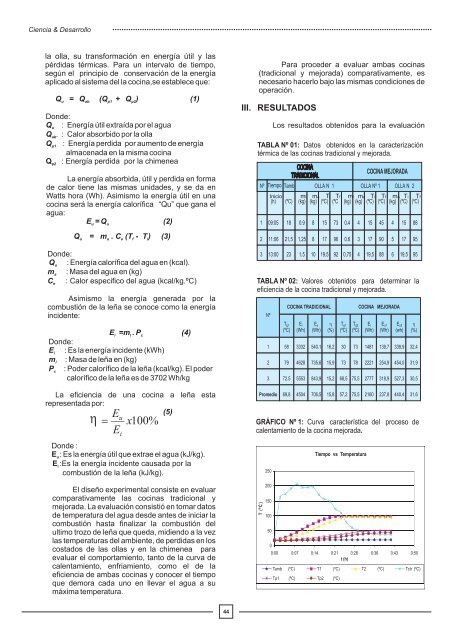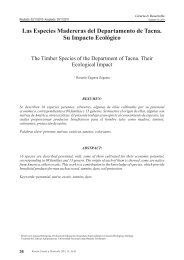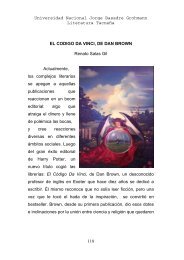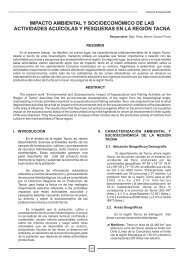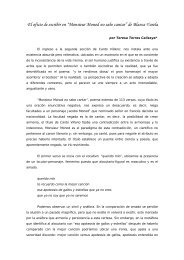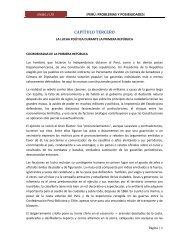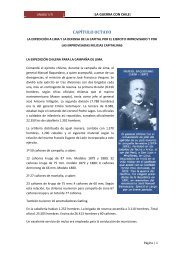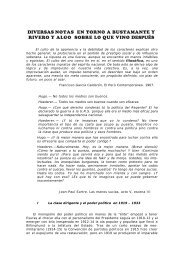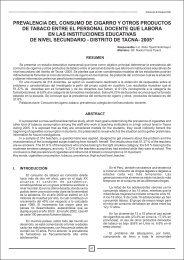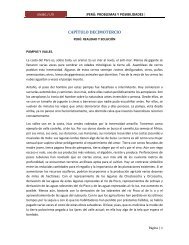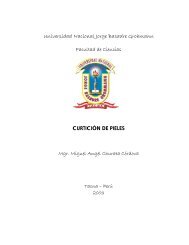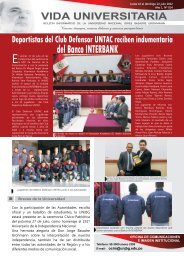desarrollo de nuevas tecnologías para la cocción de alimentos
desarrollo de nuevas tecnologías para la cocción de alimentos
desarrollo de nuevas tecnologías para la cocción de alimentos
You also want an ePaper? Increase the reach of your titles
YUMPU automatically turns print PDFs into web optimized ePapers that Google loves.
Ciencia & Desarrollo<br />
<strong>la</strong> ol<strong>la</strong>, su transformación en energía útil y <strong>la</strong>s<br />
pérdidas térmicas. Para un intervalo <strong>de</strong> tiempo,<br />
según el principio <strong>de</strong> conservación <strong>de</strong> <strong>la</strong> energía<br />
aplicado al sistema <strong>de</strong>l <strong>la</strong> cocina,se establece que:<br />
Q = Q (Q + Q ) (1)<br />
u ab p1 p2<br />
Don<strong>de</strong>:<br />
Q : Energía útil extraída por el agua<br />
u<br />
Q . : Calor absorbido por <strong>la</strong> ol<strong>la</strong><br />
ab<br />
Q : Energía perdida por aumento <strong>de</strong> energía<br />
p1<br />
almacenada en <strong>la</strong> misma cocina<br />
Q : Energía perdida por <strong>la</strong> chimenea<br />
p2<br />
La energía absorbida, útil y perdida en forma<br />
<strong>de</strong> calor tiene <strong>la</strong>s mismas unida<strong>de</strong>s, y se da en<br />
Watts hora (Wh). Asimismo <strong>la</strong> energía útil en una<br />
cocina será <strong>la</strong> energía calorífica “Qu” que gana el<br />
agua:<br />
E = Q (2)<br />
u u<br />
Q = m . C (T - T ) (3)<br />
u a e f i<br />
Don<strong>de</strong>:<br />
Q u : Energía calorífica <strong>de</strong>l agua en (kcal).<br />
m a : Masa <strong>de</strong>l agua en (kg)<br />
C e : Calor especifico <strong>de</strong>l agua (kcal/kg.ºC)<br />
Asimismo <strong>la</strong> energía generada por <strong>la</strong><br />
combustión <strong>de</strong> <strong>la</strong> leña se conoce como <strong>la</strong> energía<br />
inci<strong>de</strong>nte:<br />
Don<strong>de</strong>:<br />
E =m . P (4)<br />
i l c<br />
E : Es <strong>la</strong> energía inci<strong>de</strong>nte (kWh)<br />
i<br />
m : Masa <strong>de</strong> leña en (kg)<br />
l<br />
P : Po<strong>de</strong>r calorífico <strong>de</strong> <strong>la</strong> leña (kcal/kg). El po<strong>de</strong>r<br />
c<br />
calorífico <strong>de</strong> <strong>la</strong> leña es <strong>de</strong> 3702 Wh/kg<br />
La eficiencia <strong>de</strong> una cocina a leña esta<br />
representada por:<br />
(5)<br />
Eu<br />
x100%<br />
E<br />
i<br />
Don<strong>de</strong> :<br />
E u : Es <strong>la</strong> energía útil que extrae el agua (kJ/kg).<br />
E i :Es <strong>la</strong> energía inci<strong>de</strong>nte causada por <strong>la</strong> .<br />
combustión <strong>de</strong> <strong>la</strong> leña (kJ/kg).<br />
El diseño experimental consiste en evaluar<br />
com<strong>para</strong>tivamente <strong>la</strong>s cocinas tradicional y<br />
mejorada. La evaluación consistió en tomar datos<br />
<strong>de</strong> temperatura <strong>de</strong>l agua <strong>de</strong>s<strong>de</strong> antes <strong>de</strong> iniciar <strong>la</strong><br />
combustión hasta finalizar <strong>la</strong> combustión <strong>de</strong>l<br />
ultimo trozo <strong>de</strong> leña que queda, midiendo a <strong>la</strong> vez<br />
<strong>la</strong>s temperaturas <strong>de</strong>l ambiente, <strong>de</strong> perdidas en los<br />
costados <strong>de</strong> <strong>la</strong>s ol<strong>la</strong>s y en <strong>la</strong> chimenea <strong>para</strong><br />
evaluar el comportamiento, tanto <strong>de</strong> <strong>la</strong> curva <strong>de</strong><br />
calentamiento, enfriamiento, como el <strong>de</strong> <strong>la</strong><br />
eficiencia <strong>de</strong> ambas cocinas y conocer el tiempo<br />
que <strong>de</strong>mora cada uno en llevar el agua a su<br />
máxima temperatura.<br />
44<br />
Para proce<strong>de</strong>r a evaluar ambas cocinas<br />
(tradicional y mejorada) com<strong>para</strong>tivamente, es<br />
necesario hacerlo bajo <strong>la</strong>s mismas condiciones <strong>de</strong><br />
operación.<br />
III. RESULTADOS<br />
TABLA Nº 01: Datos obtenidos en <strong>la</strong> caracterización<br />
térmica <strong>de</strong> <strong>la</strong>s cocinas tradicional y mejorada.<br />
COCINA MEJORADA<br />
TABLA Nº 02: Valores obtenidos <strong>para</strong> <strong>de</strong>terminar <strong>la</strong><br />
eficiencia <strong>de</strong> <strong>la</strong> cocina tradicional y mejorada.<br />
Nº<br />
Los resultados obtenidos <strong>para</strong> <strong>la</strong> evaluación<br />
COCINA TRADICIONAL COCINA MEJORADA<br />
GRÁFICO Nº 1: Curva característica <strong>de</strong>l proceso <strong>de</strong><br />
calentamiento <strong>de</strong> <strong>la</strong> cocina mejorada.<br />
T (º C )<br />
Inicio ml ma Ti Tf ml ma Ti Tf ma Ti Tf<br />
250<br />
200<br />
150<br />
100<br />
50<br />
0<br />
, ,<br />
, ,<br />
Tiempo vs Temperatura<br />
0:00 0:07 0:14 0:21 0:28 0:36 0:43 0:50<br />
t (h)<br />
Tamb (ºC) T1 (ºC) T2 (ºC)<br />
Tp1 (ºC) Tp2 (ºC)<br />
,<br />
,<br />
,<br />
,<br />
, , ,<br />
, ,<br />
,<br />
,<br />
,<br />
, , , , , , , ,<br />
,<br />
,<br />
,<br />
,<br />
,<br />
,<br />
,<br />
,<br />
,<br />
(ºC)


